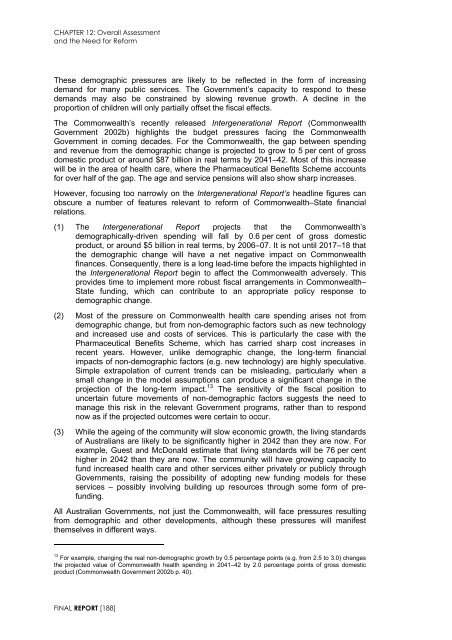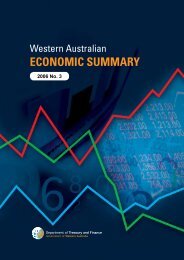Garnaut Fitzgerald Review of Commonwealth-State Funding
Garnaut Fitzgerald Review of Commonwealth-State Funding
Garnaut Fitzgerald Review of Commonwealth-State Funding
Create successful ePaper yourself
Turn your PDF publications into a flip-book with our unique Google optimized e-Paper software.
CHAPTER 12: Overall Assessment<br />
and the Need for Reform<br />
These demographic pressures are likely to be reflected in the form <strong>of</strong> increasing<br />
demand for many public services. The Government’s capacity to respond to these<br />
demands may also be constrained by slowing revenue growth. A decline in the<br />
proportion <strong>of</strong> children will only partially <strong>of</strong>fset the fiscal effects.<br />
The <strong>Commonwealth</strong>’s recently released Intergenerational Report (<strong>Commonwealth</strong><br />
Government 2002b) highlights the budget pressures facing the <strong>Commonwealth</strong><br />
Government in coming decades. For the <strong>Commonwealth</strong>, the gap between spending<br />
and revenue from the demographic change is projected to grow to 5 per cent <strong>of</strong> gross<br />
domestic product or around $87 billion in real terms by 2041–42. Most <strong>of</strong> this increase<br />
will be in the area <strong>of</strong> health care, where the Pharmaceutical Benefits Scheme accounts<br />
for over half <strong>of</strong> the gap. The age and service pensions will also show sharp increases.<br />
However, focusing too narrowly on the Intergenerational Report’s headline figures can<br />
obscure a number <strong>of</strong> features relevant to reform <strong>of</strong> <strong>Commonwealth</strong>–<strong>State</strong> financial<br />
relations.<br />
(1) The Intergenerational Report projects that the <strong>Commonwealth</strong>’s<br />
demographically-driven spending will fall by 0.6 per cent <strong>of</strong> gross domestic<br />
product, or around $5 billion in real terms, by 2006–07. It is not until 2017–18 that<br />
the demographic change will have a net negative impact on <strong>Commonwealth</strong><br />
finances. Consequently, there is a long lead-time before the impacts highlighted in<br />
the Intergenerational Report begin to affect the <strong>Commonwealth</strong> adversely. This<br />
provides time to implement more robust fiscal arrangements in <strong>Commonwealth</strong>–<br />
<strong>State</strong> funding, which can contribute to an appropriate policy response to<br />
demographic change.<br />
(2) Most <strong>of</strong> the pressure on <strong>Commonwealth</strong> health care spending arises not from<br />
demographic change, but from non-demographic factors such as new technology<br />
and increased use and costs <strong>of</strong> services. This is particularly the case with the<br />
Pharmaceutical Benefits Scheme, which has carried sharp cost increases in<br />
recent years. However, unlike demographic change, the long-term financial<br />
impacts <strong>of</strong> non-demographic factors (e.g. new technology) are highly speculative.<br />
Simple extrapolation <strong>of</strong> current trends can be misleading, particularly when a<br />
small change in the model assumptions can produce a significant change in the<br />
projection <strong>of</strong> the long-term impact. 13 The sensitivity <strong>of</strong> the fiscal position to<br />
uncertain future movements <strong>of</strong> non-demographic factors suggests the need to<br />
manage this risk in the relevant Government programs, rather than to respond<br />
now as if the projected outcomes were certain to occur.<br />
(3) While the ageing <strong>of</strong> the community will slow economic growth, the living standards<br />
<strong>of</strong> Australians are likely to be significantly higher in 2042 than they are now. For<br />
example, Guest and McDonald estimate that living standards will be 76 per cent<br />
higher in 2042 than they are now. The community will have growing capacity to<br />
fund increased health care and other services either privately or publicly through<br />
Governments, raising the possibility <strong>of</strong> adopting new funding models for these<br />
services – possibly involving building up resources through some form <strong>of</strong> prefunding.<br />
All Australian Governments, not just the <strong>Commonwealth</strong>, will face pressures resulting<br />
from demographic and other developments, although these pressures will manifest<br />
themselves in different ways.<br />
13<br />
For example, changing the real non-demographic growth by 0.5 percentage points (e.g. from 2.5 to 3.0) changes<br />
the projected value <strong>of</strong> <strong>Commonwealth</strong> health spending in 2041–42 by 2.0 percentage points <strong>of</strong> gross domestic<br />
product (<strong>Commonwealth</strong> Government 2002b p. 40).<br />
FINAL REPORT [188]

















